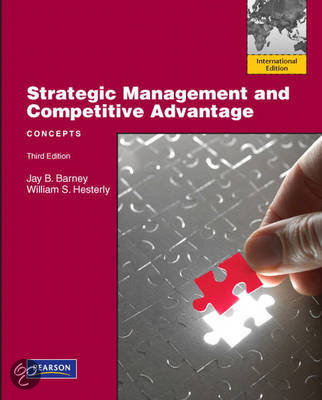PART 3: Corporate strategies
CHAPTER 8: Vertical integration
Objective 8.1: Define corporate strategy
What is corporate strategy?
Corporate strategy is a firm’s theory of how to gain competitive
advantage by operating in several businesses simultaneously.
Decisions about whether to vertically integrate often determine
whether a firm is operating in a single business or industry or in
multiple businesses or industries. Other corporate strategies discussed in this book include,
diversification, strategic alliances, and mergers and acquisitions.
Objective 8.2: Define vertical integration, forward vertical integration and backward
integration
What is vertical integration?
As a reminder, a value chain is that set of activities that must be accomplished to bring a
product or service from raw materials to the point that it can be sold to a final customer.
A firm’s level of vertical integration is simply the number of steps in this value chain that a
firm accomplishes within its boundaries. Firms that are more vertically integrated
accomplish more stages of the value chain within their boundaries than firms that are less
vertically integrated.
A firm engages in backward vertical integration when it incorporates more stages of the
value chain within its boundaries and those stages bring it closer to the beginning of the
value chain, that is, closer to gaining access to raw materials.
A firm engages in forward
vertical integration when
it incorporates more
stages of the value chain
within its boundaries and
those stages bring it closer
to the end of the value
chain, that is, closer to
interacting directly with
final customers.
,Objective 8.3: Discuss how vertical integration can create value
Vertical integration and the threat of opportunism
Opportunism exists when a firm is unfairly exploited in an exchange. Examples of
opportunism include when a party to an exchange expects a high level of quality in a product
it is purchasing, only to discover it has received a lower level of quality than it expected.
When will the threat of opportunism be large enough to warrant vertical integration?
Research has shown that the threat of opportunism is greatest when a party to an exchange
has made transaction-specific investments.
A transaction-specific investment is any investment an exchange that has significantly more
value in the current exchange than it does in alternative exchanges.
Vertical integration and firm capabilities
A second approach to vertical integration decisions focuses on a firm’s capabilities and its
ability to generate sustained competitive advantages. This approach has two broad
implications: (1) it suggests that firms should vertically integrate into those business
activities where they possess valuable, rare and costly-to-imitate resources and capabilities.
(2) This approach also suggests that firms should not vertically integrate into business
activities where they do not possess the resources necessary to gain competitive
advantages.
Vertical integration and flexibility
Flexibility refers to how costly it is for a firm to alter its strategic and organizational
decisions. Flexibility is high when the cost of changing strategic choices is low → flexibility is
low when the cost of changing strategic choices is high.
Applying the theories to the management of call centers
One of the most common business functions to be outsources, and even offshored, is a
firm’s call center activities. So, what do these three theories say about how call centers
should be managed: when should they be brought within the boundaries of a firm, and when
should they be outsourced? Each of these theories will be discussed in turn.
o Transaction-specific investments and managing call centers
When applying opportunism-based explanations of vertical integration, start by looking for
actual or potential transaction-specific investments that would need to be made to complete
an exchange. High levels of such investments suggest the need for vertical integration, low
levels of such investments suggest that vertically integrating this exchange is not necessary.
o Capabilities and managing call centers
In opportunism-based explanations of vertical integration, you start by looking for
transaction-specific investments and then make vertical integration decisions based on these
investments. In capability-based approaches, you start by looking for valuable, rare, and
costly-to-imitate resources and capabilities and then make vertical integration decisions
appropriately.
, o Flexibility and managing call centers
Opportunism logic suggests starting with a search for transaction-specific investments,
capabilities logic suggests starting with a search for valuable, rare, and costly-to-imitate
resources and capabilities. Flexibility logic suggests starting by looking for sources of
uncertainty in an exchange.
Objective 8.4: Describe conditions under which vertical integration can be a source of
sustained competitive advantage
Vertical integration and sustained competitive advantage
Of course, for vertical integration to be a source of sustained competitive advantage, not
only must it be valuable, it must also be rare and costly to imitate, and a firm must be
organized to implement it correctly.
The rarity of vertical integration
A firm’s vertical integration strategy is rare when few competing firms can create value by
vertically integrating in the same way. A firm’s vertical integration strategy can be rare
because it is one of a small number of competing firms that can vertically integrate
efficiently or because it is one of a small number of firms that is able to adopt a non-
vertically integrated approach to managing an exchange.
o Rare vertical integration
A firm may be able to create value through vertical integration, when most of its
competitors are not able to, for at least three reasons. Not surprisingly, these reasons
parallel the three explanations of vertical integration presented in this chapter: (1) rare
transaction-specific investments and vertical integration, (2) rare capabilities and vertical
integration and (3) rare uncertainty and vertical integration.
o Rare vertical dis-integration
Each of the examples of vertical integration and competitive advantage described so far has
focused on a firm’s ability to vertically integrate to create competitive advantage. However,
firms can also gain competitive advantages through their decisions to vertically dis-integrate,
that is, through the decisions to outsource an activity that used to be within the boundaries
of the firm.
The imitability of vertical integration
The extent to which these rare vertical integration decisions can be sources of sustained
competitive advantage depends, as always, on the imitability of the rare resources that give
a firm at least a temporary competitive advantage. Both direct duplication and substitution
can be used to imitate another firm’s valuable and rare vertical integration choices.
o Direct duplication of vertical integration
Direct duplication occurs when competitors develop or obtain the resources and capabilities
that enable another firm to implement a valuable and rare vertical integration strategy.





